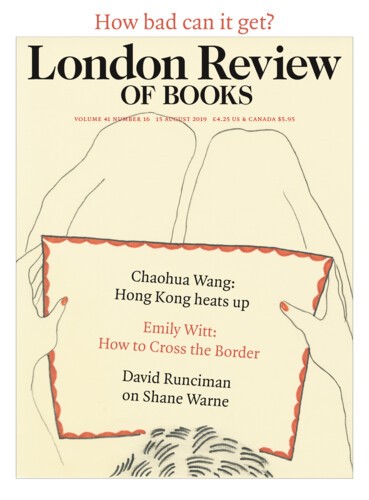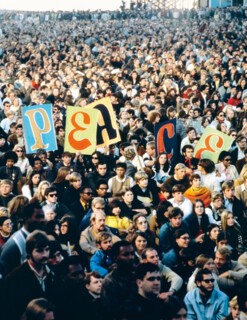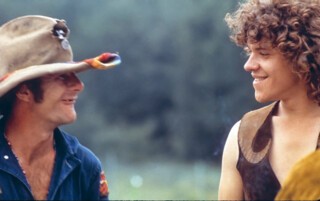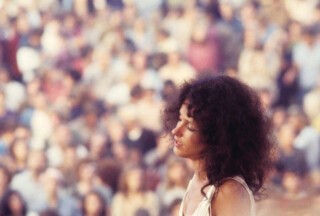This month marks the fiftieth anniversary of the Woodstock festival. Michael Lang, the tenacious 24-year-old who made Woodstock happen, has a habit of surfacing at Woodstock birthdays: one book to mark the tenth anniversary, another to mark the fortieth, a couple of namesake concerts and now a coffee-table volume of photos from the 1969 festival, plus brief explanatory notes. Earlier this year he announced the line-up for a fiftieth birthday event at the Glen, a racetrack 150 miles from the original site. Performers included Miley Cyrus and Jay-Z. A few wrinkly legends, including the Zombies and Robert Plant (Led Zeppelin famously turned down the offer to play fifty years ago) were also billed, alongside veterans from the founding festival: Santana, David Crosby, Country Joe McDonald, the remains of the Grateful Dead, Canned Heat and others.
But Lang’s fifty-up began to unravel when his top-dog investor, the Japanese digicoms company Dentsu Aegis, announced from its London HQ that it was pulling out. Like many ageing music promoters, Lang can nowadays afford expensive lawyers, but his suit against Dentsu Aegis didn’t go the way he’d hoped. In May the investment bankers Oppenheimer Holdings stepped into the breach, only to discover that the Glen was no longer willing to host. Woodstock Fifty is dead in the water. A rival anniversary event near the original site could yet happen, but Lang set his lawyers on the organisers with a writ to cease and desist– though his case looks shaky now that his own project has foundered.
There are nasty echoes here of the knife-edge countdown to Woodstock 1969. In those days Lang was a charismatic hippie from Brooklyn who had staged a festival in Florida. He was hoping to build a music studio in Woodstock, New York State, where he was hanging out at the time. Van Morrison was living in the vicinity, Bob Dylan too. Lang approached two wealthy young entrepreneurs to fund the studio project, and one of them, Joel Rosenman, suggested it might make more sense to put money into a live event. Woodstock Ventures was duly constituted and the team set to work on a ‘music and arts fair’.
But who would lease the land for a gathering of fifty or sixty thousand people? Lang had set his heart on a farm in Saugerties, a few miles east of Woodstock on the Hudson River, but then the local council gave him the cold shoulder. He and his colleagues found another site in Orange County; the residents were opposed. ‘We got the hell out of Dodge, aiming to put the bad vibes behind us,’ Lang remembers. They had lost a precious four weeks, the festival date was looming and they were still scouting for a location. One day, driving around Sullivan County, they reached the brow of a hill and saw the perfect spot below. ‘I shouted, “Stop the car!” as the field of my dreams appeared before us.’ They were about 75 miles out of Woodstock in the rural hamlet of Bethel (population 2700). The property was owned by Max Yasgur, a 49-year-old dairy farmer born to Russian Jewish immigrants. Yasgur and his wife, Miriam, had six hundred acres and a large herd of Guernsey cows. They struck a deal with Woodstock Ventures – $50,000 for the loan of the land, according to Rolling Stone’s coverage of the event the following month.
Some say that Yasgur actually agreed to much less, but he never let on. The project needed someone obstinate, with an eye on his own interests and a willingness to court hostility in the county. Lang had found his man. Without Yasgur, we wouldn’t have ‘Freedom (Motherless Child)’, the high point of Richie Havens’s opening set, or Janis Joplin’s drastic version of ‘Ball and Chain’, which was meant to be performed on day two but wasn’t heard until the small hours of day three: rain was already delaying the programme. Or the ragged version of ‘Wooden Ships’, delivered by Jefferson Airplane about five hours later; or ‘The Star-Spangled Banner’ eventually performed by Jimi Hendrix at around 10 or 11 a.m. on day four: a torrential rainstorm had brought things to a standstill the previous afternoon and Hendrix didn’t make it onto the stage until Monday morning; most of the crowd had already left.
With Martin Luther King and Robert Kennedy assassinated, Nixon in the White House, the Salt I treaty still a few years off and nearly half a million troops in Vietnam, three of those memorable turns were in ‘protest’ mode: Havens’s sampling of the 19th-century spiritual ‘Motherless Child’ sounds now – and maybe did at the time – like a reminder that Lyndon Johnson’s Great Society had left many African Americans out in the cold. In ‘Wooden Ships’, a post-nuclear daydream, the singers – Grace Slick and Paul Kantner – are sailing away from America, exchanging iodine tablets with other survivors and looking back at figures on the shoreline moving around in silver hazmat suits. ‘The Star-Spangled Banner’, a travesty of the national anthem performed on a Stratocaster, speaks to violence at home and war abroad. Johnson’s bombing campaign in North Vietnam, which had wound up in November the previous year, was still fresh in people’s minds, and it transpired later that Hendrix had closed out the festival six months – to the day – after Nixon began bombing Cambodia. At the time the American public and almost every member of Congress was in the dark.
There was a space at the festival known as Movement City where political movements, including Students for a Democratic Society, put up stalls. But according to Lang, who felt bullied by left activists, few were interested. During the Who’s act, the Yippies’ co-founder, Abbie Hoffman, grabbed a mike to denounce the incarceration of a White Panther party militant and the festival along with it: ‘I think this is a pile of shit while John Sinclair rots in prison.’ (Like Hoffman, Pete Townshend went off-message from ‘the spirit of Woodstock’ at that point. ‘Fuck off!’ he announced. ‘Fuck off my fucking stage!’) But Lang never imagined the festival as a political event and it never was: this was a countercultural outing, ‘an Aquarian exposition’ according to the Woodstock Ventures pitch. Both hedonistic and moralistic, it was a showcase for the alternative way of life espoused by restless young Americans two years after the summer of love in Haight-Ashbury and a few months before the chaos of the Altamont festival. There were only two deaths at Woodstock: one person died of a drug overdose – or possibly insulin – and another was killed by a tractor while sleeping in a field. In Altamont four died, including Meredith Hunter, an African American stabbed and kicked to death by Hell’s Angels while the Rolling Stones were playing. As Greil Marcus summed it up later, a young black man in a predominantly white crowd was murdered ‘by white thugs as white men played their version of black music’.
Altamont, the columnists pronounced, had brought the curtain down on two exemplary years of peace and music, which peaked at Woodstock, but this story didn’t really stack up in the face of assassination, judicial killing and hippie perversity. In Los Angeles, a week before the Woodstock festival, the Manson family murdered Sharon Tate and four other people in a lavish killing spree. In Chicago, two days before Altamont, the FBI and the city’s police department conspired in a dawn raid on the apartment of Fred Hampton, a precocious and brilliant Black Panther Party organiser, aged 21, and shot him dead.
The legend of Woodstock owed much to the utopian resolve of the crowd as well as the free-flowing recreational drugs. By day three, with rain driving down onto the Catskills, the dreamy dip in the land that Lang had spotted from the crest of a hill in Bethel was a sump of mud, but the audience were not prepared to let the festival go down as a wash-out. The arrangements that Lang and his colleagues had put in place at the last minute were crucial: drinking water, toilets, security, food, medics who could deal with physical injuries – mostly to barefoot hippies – and head wounds (bad LSD trips and prodigal abuse of Class B drugs).
Even so there was an enormous unforeseen problem. Lang’s highest estimate for the audience in Bethel was 150,000, but 400,000 people, maybe 450,000, were gathering on Yasgur’s farm. Food quickly ran short and the vast traffic tailbacks across the county made resupply difficult. Tempers rose as onsite vendors ramped up prices. In a rare act of aggression a vendor’s stall was torched. Hundreds – maybe thousands – of furious fans had already given up in disgust, having failed to negotiate the gridlocked roads of Sullivan County, or if they’d made it, found themselves rapidly disillusioned by the fact that they couldn’t hear the bands half a mile from the stage. Still it was obvious that the vast numbers who held on regardless – ‘the kids’, as people insisted on calling them – were as vulnerable as their numbers were impressive. Help was at hand from local people who may well have disapproved of the event but who nevertheless rapidly came together as a small army of foster carers. The county sheriff called in the US Army medical corps, which delivered blankets, tinned food and water in Huey helicopters along with bulky packs of sandwiches, in a momentary truce between the crowd and their cartoon villains, the military. When that wasn’t enough to feed the 400,000, the Jewish community centre women’s group in Monticello, the nearest town, put their misgivings aside and produced another 30,000 sandwiches, distributed by the Sisters of the Convent of St Thomas in a bustling, ecumenical show of mothering. By comparison with Woodstock, the miracle of the Sermon on the Mount – five loaves and two fishes – looks like a radical stunt.
Then, crucially, there was the stakhanovite hippie kitchen. Before the festival Woodstock Ventures had enlisted the support of the Hog Farm, a group of hippies named for the site of their commune in California. The members, who had recently bought a piece of land in New Mexico, were on the move, but they were diverted by Lang & Co and persuaded that they could help tens of thousands of young city-dwellers handle the great outdoors for a few days. The Hog Farmers liked the idea – and a dozen capable, back-to-the-land hippies readied the site. About a week before the festival another 85 were brought in to chaperone the crowds. It was the Hog Farmers who suggested there should be Aquarian food on offer and plenty of it. That turned out to be a critical call: large quantities of brown rice, beans and granola kept hunger levels down as the vendors ran dry. The Hog Farmers were joined by a group of Merry Pranksters in Ken Kesey’s bus, Furthur. The old banger, originally a school bus, was clapped out by then, and the trip to Woodstock was one of its last outings.
It was clear as the crowds poured in that Lang had to beef up his medical team: seven doctors, 36 nurses and 18 assistants. Airlifts brought the eventual tally to more than twenty doctors and two hundred nurses. There were countless volunteers, including Hoffman, who – when he wasn’t being told off by Townshend – worked in the medical tents. But the most striking logistical feat at Woodstock was security. Perhaps in desperation, Woodstock Ventures decided to enlist the Hog Farmers not just as groovy scoutmasters but as laid-back law enforcement too. The Hog Farm hippies were blissfully unaware of this assignment and found out only when the extra 85 hands landed at JFK and the press asked them how they proposed to keep order. Their practicality and social skills – try living in a commune – should have meant they were cut out for the job. But how would their main man, Wavy Gravy, a comic performer and nomadic MC, deploy his people in a situation that got seriously out of hand?*
Lang & Co had thought this through and engaged the services of a private security expert called Wes Pomeroy, who had served as a policeman and a marine. As a deputy sheriff in California he had kept order at a tense Republican Convention and later been appointed as a special assistant to Johnson’s attorney general, Ramsey Clark. Nixon had just got rid of him and now, in his late forties, he had started his own consultancy. The organisers were against conspicuous policing, and so was Pomeroy. He would be the watchful father looking through the window as the young began to party in the garden. His men would wear sola topis and red T-shirts emblazoned with the logo ‘Peace’; they would fade discreetly behind a haze of ambient smoke put up by the obliging crowd.
A swathe of New York State, from Sullivan County south to the five boroughs, was the obvious place to tout for off-duty police looking for an extra weekend’s earnings. And the NYPD agreed to this in principle. Pomeroy was already interviewing hundreds of cops, sounding out their attitude to hippie crowds and building up his team, when Wavy Gravy pitched up with his Hog Farm auxiliaries at JFK and fielded that disarming question about their policing duties from the assembled press. Wavy Gravy, wearing a cowboy hat with a hole at the front, said he might just manage a ‘please force’. The commissioner and his police chief in New York recoiled in horror and issued a warning that any NYPD officer found working hand in hand with a bunch of Californian hippies would be barred from duty. Pomeroy was now on the back foot. He opened up a moonlighting conduit for police whose profiles matched his requirements: ‘We want you to work at a rock festival upstate, where thousands of kids will be relaxed and easygoing, and dressed in lots of different ways … No weapons of any kind will be allowed – no guns or nightsticks. Your role is going to be to help people … and if the kids need to know how to get help, you help them.’ Pomeroy enlisted nearly three hundred officers at $50 a day, all registering under pseudonyms, many borrowed from characters in Disney cartoons. They turned out, in Lang’s account, to be key participants, backing up state troopers, unblocking traffic jams and assisting at drug emergencies.
Woodstock was a logistical miracle: the festival should have been a disaster, as it was for the investors. Woodstock Ventures were selling advance tickets at $6.50 for a day or $18 for all three; the price at the gate would be $24. But then, under pressure of numbers, they had to turn it into a free event. The land had taken a hammering and there were lawsuits from neighbouring farmers to settle. But year on year, box office earnings from the documentary (Woodstock, released in 1970) balanced out the losses, while the movie itself consolidated the myth. Not everyone liked to hear Woodstock talked up years afterwards. On NPR at the quarter-centenary in 1994, Martha Bayles argued that Woodstock was largely a conventional affair, ‘very much in the American grain’: ‘kind of a revival meeting’, she said, ‘that smacked of the outdoor camp meeting, a Methodist meeting’. It’s a tricky assertion, given the kinds of hedonism on show, but she was right to think of the festival as a congregation of pilgrims who had found a place – and an altar of some kind – where they could worship together.
Marcus, who was at Woodstock as well as Altamont, never doubted that something ‘odd, fundamental and new’ had happened on Yasgur’s farm. He called it a ‘magnificent accident’. There were other, powerful ways of saying the same thing. The chief of police in Monticello told the press: ‘They are the most courteous, considerate and well-behaved group of kids I have ever been in contact with in my 24 years of police work.’ Yasgur announced with a sigh of relief: ‘The kids were wonderful, honest, sincere – good kids who said: “Here we are. This is what we are …” They forced me to open my eyes. I think America has to take notice.’ It did – and dozens of upright rural communities from sea to shining sea swore that they would never allow the same thing to happen in their own backyards.
A marvellous deadpan account of Woodstock by an old left activist was posted ten years ago on a blog called ‘Fire on the Mountain’. The writer, Jimmy Higgins, a member of SDS, helped to run their stall in Movement City. Higgins had no time for hippie entrepreneurs like Lang and he wasn’t hanging out at Woodstock for the rock ’n’ roll. Hoffman, he recalled, had threatened Woodstock Ventures with ‘massive disruption’ if they didn’t equip Movement City to his demanding standards: the result was ‘a big-ass tent, a spanky new printing press and thousands of dollars’ worth of goodies’. When the festival was over Higgins stood guard until some comrades came with a rental van and loaded up whatever took their fancy, including the press. At the time Higgins had doubts about the Weather Underground – a radical group which had risen through fissures in SDS to become advocates of violence at home (a proportionate response, in their view, to the miseries inflicted on the Vietnamese). While he was putting up the stall, with two days to go before the festival kicked off, Higgins found himself outnumbered by ‘Weather types in their early wannabe streetfighting mode’. But he approved when they appropriated a vendor’s stall and he went off with them to sabotage the chain-link fence around the site which ‘Lang’s crews were humping to get set up before Friday’.
Once the Weather contingent took LSD they were a lost cause, according to Higgins, fleeing from the site as thousands of people were pouring in: dropping acid didn’t seem to make the struggle any easier. Higgins’s best story is about the genial enforcer Wavy Gravy, shuttling between disgruntled radicals in Movement City and his jumpy patrons, keeping the peace. The night before the concert, Higgins recalls, Wavy Gravy ‘made his way to Movement City with what you might call a burnt offering – a chunk of very strong hash the size of a regulation softball’. That was a kind of policing the left could just about tolerate.
Send Letters To:
The Editor
London Review of Books,
28 Little Russell Street
London, WC1A 2HN
letters@lrb.co.uk
Please include name, address, and a telephone number.




